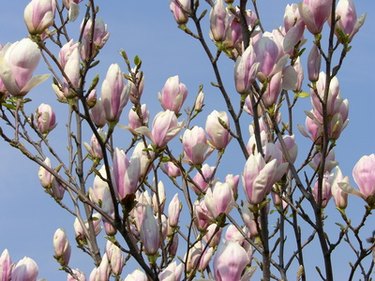
Magnolias (Magnolia spp.) are stunning, flowering trees that command attention in any landscape. There are many different types of magnolias, some of which are suitable for western Washington state. There are both deciduous and evergreen magnolia types from which to choose. The key is selecting a species that is hardy in this region, which falls in U.S. Department of Agriculture plant hardiness zones 7 and 8.
Magnolia Tree Varieties
Video of the Day
With a height and spread of up to 35 feet and blooms that may be up to a foot wide, the Sargent's magnolia (Magnolia sargentiana var. robusta) is one of the most spectacular magnolia tree types for western Washington. The flowers of the Sargent's magnolia are white on the inside and pink on the outside. It can take 10 years or longer for a Sargent's magnolia grown from seed to bloom for the first time, however.
Video of the Day
The saucer magnolia (Magnolia x soulangeana), with large flowers that resemble saucers, is also suitable for western Washington. It is hardy to zone 4. This tree has a height between 20 and 30 feet with a spread of up to 25 feet.
The Sargent's magnolia and the saucer magnolia are both deciduous, which means they lose their leaves in the fall. Make sure to give both of these species plenty of room to spread out. These trees should be protected from winds that can damage the delicate flowers.
Smaller Magnolia Varieties
If you are looking for a magnolia variety for a smaller space in western Washington, the oyama magnolia (Magnolia sieboldii) is one option to consider, as it has a maximum height of 15 feet. A deciduous species that is winter hardy to zone 6, it features white flowers with a dark red stamen in the center and blooms in May and June. Its leaves turn a golden yellow color in the fall.
The star magnolia (Magnolia stellata) is another compact, deciduous option with a height between 15 and 20 feet. It gets its name from its star-shaped flowers. Though hardy to zone 4, this species blooms in March and April, so its flowers can be damaged by a late spring frost.
You can avoid this problem by planting Magnolia stellata 'Waterlily,' a star magnolia cultivar that blooms a few weeks later than the species plant. The flowers of the Waterlily cultivar are also larger with many more tepals than flowers of the species plant.
Evergreen Magnolia Varieties
Magnolia grandiflora 'Bracken's Brown Beauty' is a cultivar of the iconic evergreen southern magnolia that is hardy to zone 5 and is also an option for western Washington. While the species southern magnolia can be 80 feet tall, this cultivar has a maximum height of 30 feet. The flowers of the Bracken's Brown Beauty magnolia tree are white and shaped like cups with a diameter of up to 6 inches.
For a smaller evergreen option suitable for western Washington, consider Magnolia grandiflora 'Little Gem,' which is hardy to zone 7. This southern magnolia cultivar has a height of about 20 feet and can take 20 years to reach that size. The Little Gem magnolia produces white flowers in May and June. Its leaves are a glossy green with a bronze-colored underside.
- Arbor Day Foundation: Saucer Magnolia
- University of Washington College of the Environment: Spring Blooms to Watch for in the Seattle Area
- The Seattle Times Pacific NW Magazine: Magnolias Add Flower Power to Any Garden
- Missouri Botanical Garden: Magnolia sieboldii
- Oregon State University College of Agricultural Sciences: Landscape Plants - Magnolia sargentiana var. robusta
- Missouri Botanical Garden: Magnolia stellata 'Waterlily'
- Missouri Botanical Garden: Magnolia grandiflora 'Little Gem'
- Missouri Botanical Garden: Magnolia grandiflora 'Bracken's Brown Beauty'